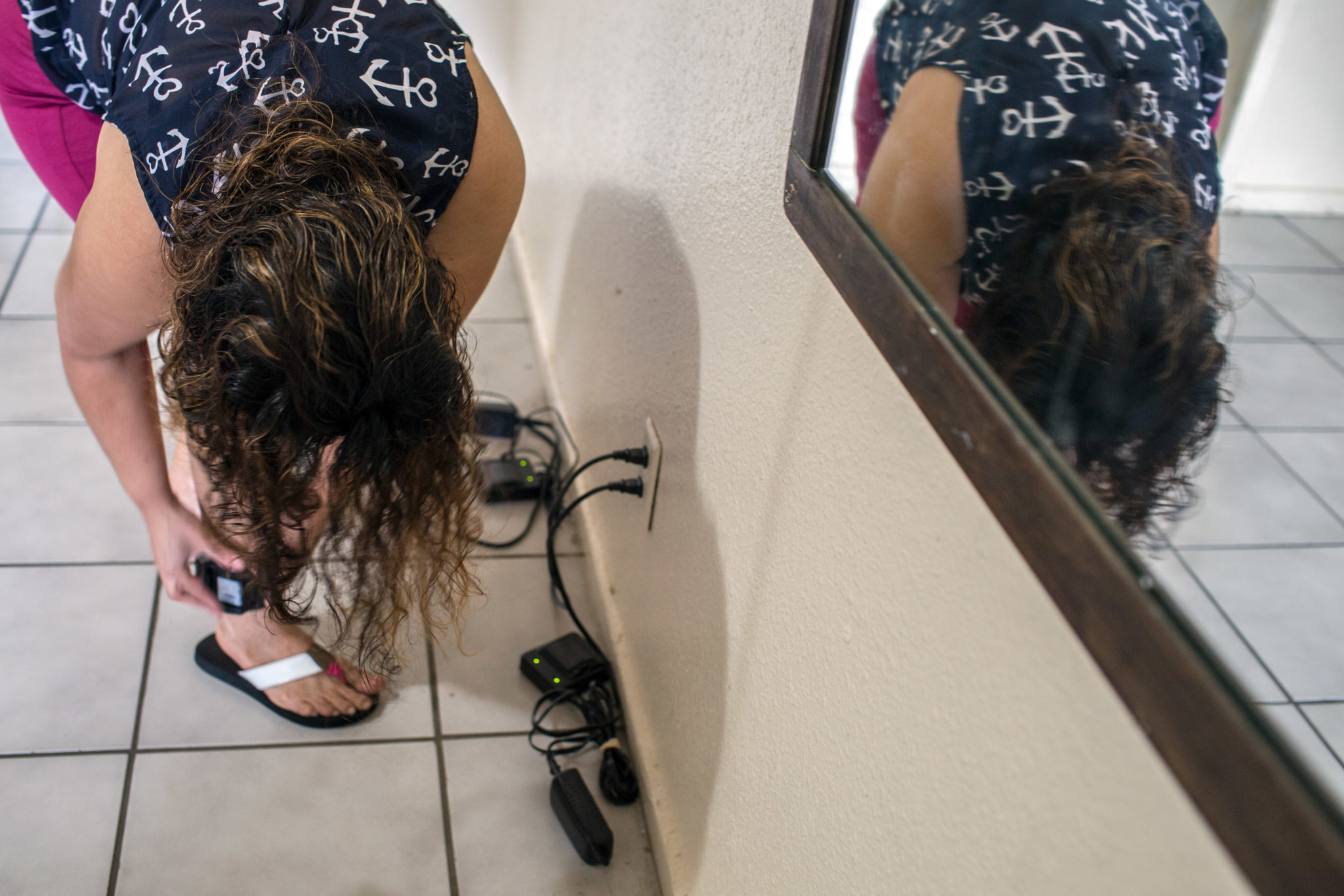
Locked In Limbo
Ankle monitors are preferable to putting immigrant families behind bars. But the devices interfere with daily life and work — and they aren’t always used as an alternative to detention.

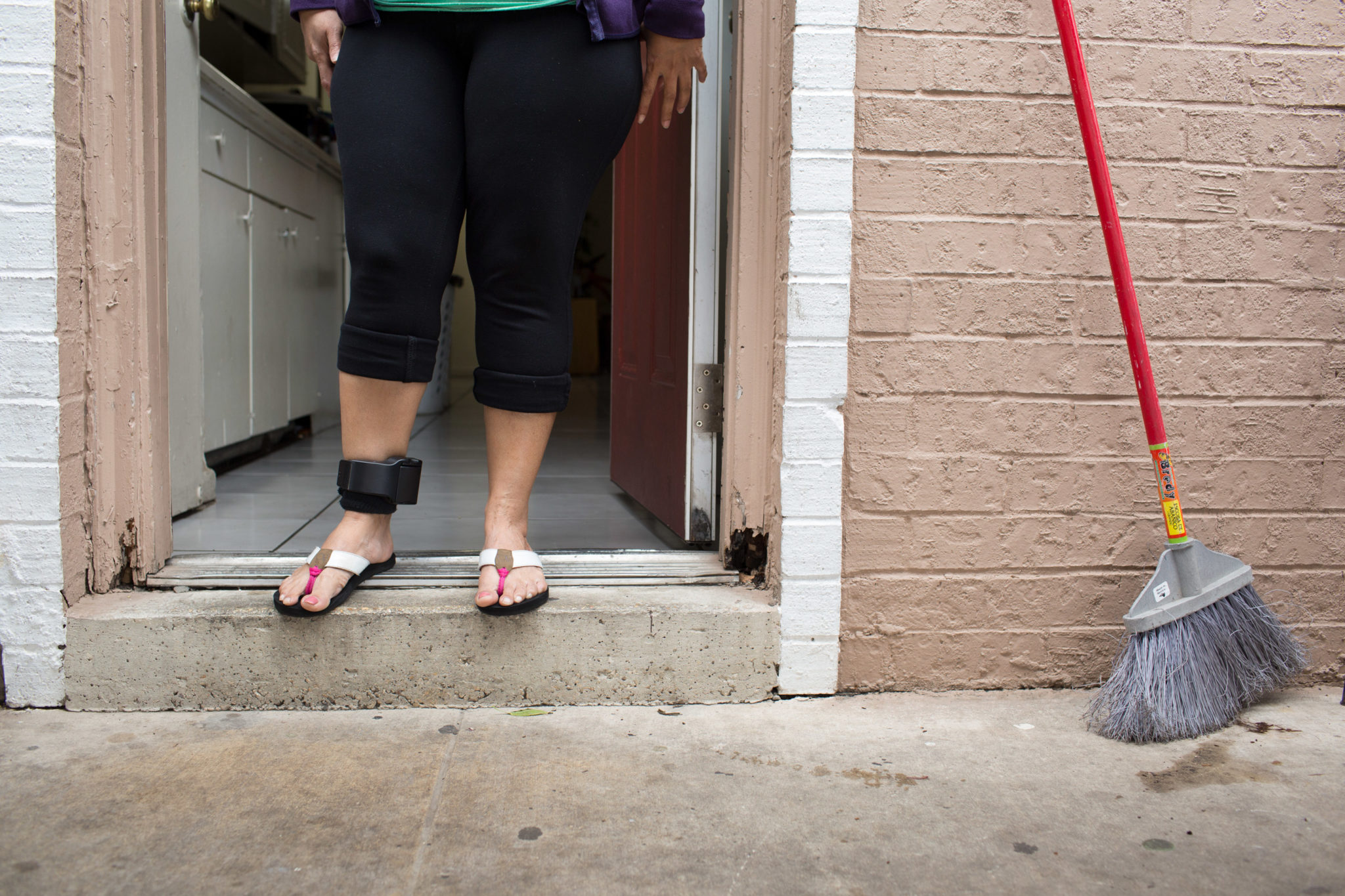
By Gus Bova
Gladys was sitting down to a plate of turkey, mashed potatoes and stuffing at her first Thanksgiving dinner in America when a loud masculine voice cried out, “La batería está descargada; cárgala por favor.” (“The battery is dead; charge it please.”)
Her three daughters averted their eyes in embarrassment. They’d gone through this before.
Gladys told her startled host, a U.S.-born Latina, that it was her cellphone. “That’s not a phone,” the host said, looking around for the source of the noise. Gladys, a 37-year-old Honduran woman with soft features and dark curly hair, muttered an excuse and left the house, tears rushing to her eyes.
For five months, ever since she threw herself on the mercy of the U.S. government, Gladys had been wearing a GPS-equipped ankle monitor. Wherever she went, it went with her. And sometimes it gave her orders. Back home that evening, she stared down at the short power cord that tethered her to the wall outlet, and wondered why the grillete, or shackle, was necessary.
In June, Gladys and her daughters had fled the city of San Pedro Sula, regularly ranked as the murder capital of the world, after the 18th Street gang threatened to kill her for reporting a car theft to the police. The gang, she said, was also scouting one of her daughters as a “girlfriend” for a leader. Gladys thought of staying in Mexico, but she knew the gang could easily reach them there. So the family carried on by bus to the international bridge that connects Ciudad Juarez and El Paso, where they turned themselves in to ask for asylum — an act protected under international law.
Gladys is one of thousands of immigrants, mostly Central American mothers, who are required to wear an ankle monitor. Given the choice between jail or the device, she chose to avoid the prison-like family detention center. Gladys is thankful to not be locked up, but at times she still feels incarcerated.
She told the Observer she’s looked for work, but hotels and restaurants won’t hire her because the customers will think she’s a criminal. And the hours she can work are limited, because she has to care for her kids, charge the monitor and be home for weekly check-ins. Then there’s the shame.
“It’s ugly to go around with this,” Gladys said, gesturing toward the monitor. “Especially for a woman. Emotionally, it affects you a lot … I feel like I can’t do anything.”
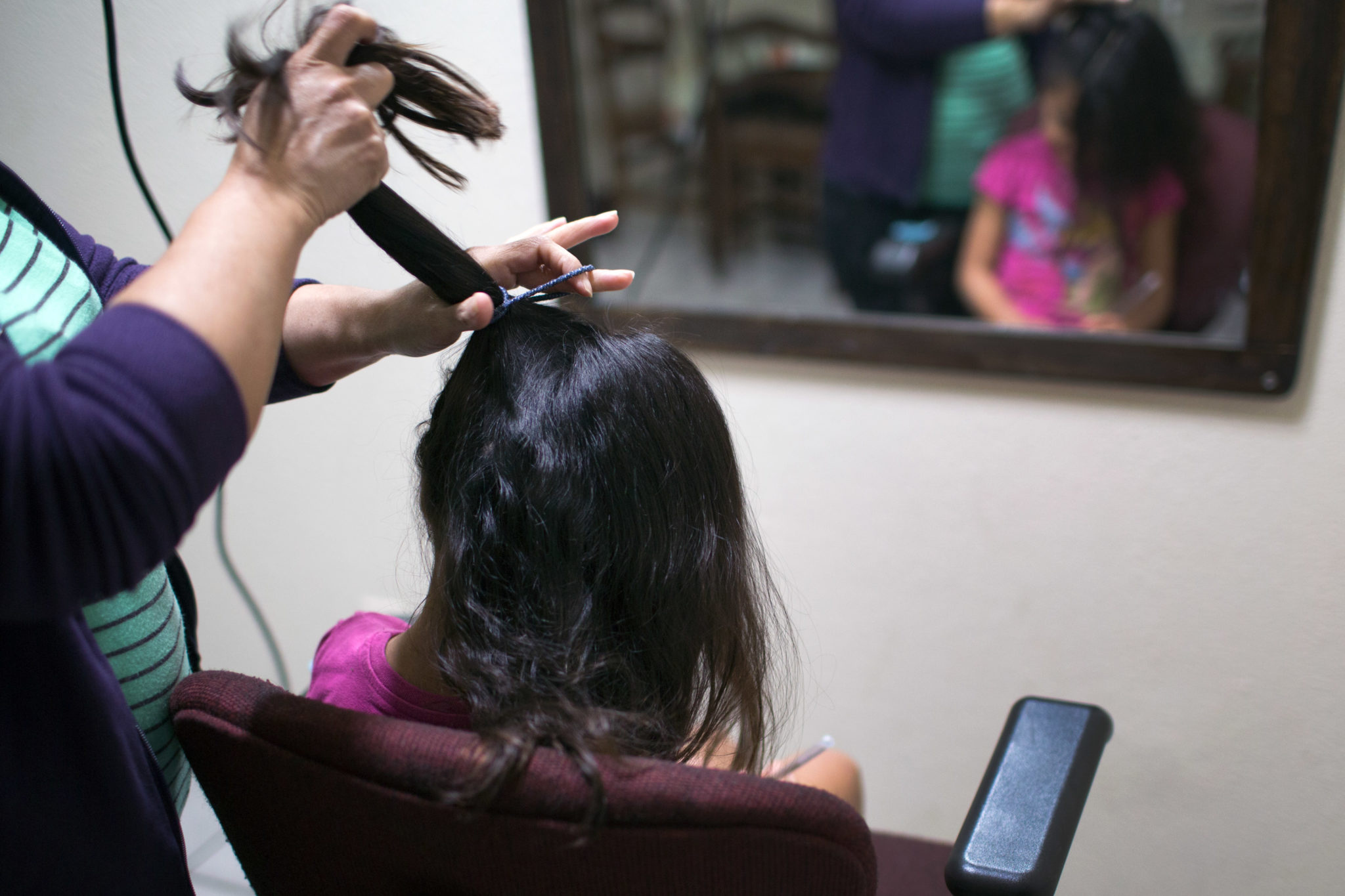
Immigration and Customs Enforcement (ICE) first began using ankle monitors on immigrants in 2005, but their use began to skyrocket after the 2014 wave of Central American asylum seekers. That year, nearly 70,000 Central American families arrived at the U.S. border. As part of its deterrence strategy, the Obama administration locked up many of them in family detention centers in South Texas, while others were released on the condition that the parent wear a monitor. By 2015, the government monitored 23,000 immigrants at any given time using ankle monitors or telephone check-ins; in 2016, that number rose to 60,000.
According to ICE, ankle monitors are an effective way to ensure that immigrants appear for their court dates without detaining them. In a statement to the Observer, spokesperson Sarah Rodriguez said the use of ankle monitors “[allows] ICE to manage individuals who may pose a flight risk, but for whom detention may not be the most appropriate option.”
In the last two years, immigrants with monitors have appeared at 99 percent of their hearings, the agency added. And at around $5 per person per day, monitors are much cheaper than detention, which costs $126 per person per day at regular detention centers and $161 at family facilities.
Advocates agree the monitors are preferable to detention, but say they’re unnecessary for asylum seekers, who have every reason to go to court. They argue that once asylum seekers pass their initial screening, they should be released to live with family or in residential shelters, where they can be connected with legal and social services.
“Ninety percent of these families pass an initial [asylum] screening about whether they have a legitimate fear of returning to their country,” said Amy Fischer, policy director for RAICES, a San Antonio group serving immigrants and refugees. “So it makes sense they would want to go to court and proceed with the asylum process, as opposed to living undocumented lives in obscurity.”
Advocates also say ankle monitors aren’t serving their function as alternatives to detention. Many immigrants are detained for months before being released with the devices. And the increase in monitors has not led to a decrease in detention. Instead, the detainee population hit an all-time high of 42,000 in October.
“I understand that in some cases, on the individual level, an ankle monitor can be preferable,” said Bob Libal, executive director of Grassroots Leadership, an Austin group that fights private prisons. “But on a systems level, it’s not accomplishing the goal of reducing the number of people in detention, or making our immigration system a more humane one.”

On a weekday morning in January, Gladys beckons me into her clean and sparsely furnished apartment in north-central San Antonio. She shares one room with her three daughters, while Yesica, a childhood friend from Honduras, occupies the other with her husband and son.
Gladys grew up poor in a small town two hours from San Pedro Sula. Her father was murdered when she was 8 years old, and her mother had to take a housekeeping job in the city. That left Gladys alone during the week to care for her four younger siblings. At 15, she moved to the city on her own to work in a sweatshop, making clothing on an assembly line. Even with her tough upbringing, the ankle monitor is hard to bear.
“When they put it on, it felt really bad,” she says, breaking into tears. “Because I knew from the movies that this is what they put on criminals.”
She shows me the monitor, a black, plastic bracelet weighing about 6 ounces. It’s made by BI Inc., a private company that runs the federal government’s alternatives-to-detention program. BI holds a lucrative, five-year contract with ICE and is owned by GEO Group, the publicly traded private prison firm that operates many detention centers. BI clasped the bracelet on Gladys’ ankle at the border, monitors her GPS signals and would receive an alarm if she tampered with the device.
The morning of my visit, Gladys is waiting for BI employees to arrive for a mandatory check-in. Every Thursday, she has to be home from 8 a.m. to noon as a condition of her release. The BI employees often don’t show up, but she can’t risk going out. If they find she’s not there, it will count as a falta, or demerit. She can also get a falta for not charging the device quickly enough when the voice goes off. Supposedly, each falta extends how long she has to wear the monitor. She’s already worn it for nine months.
“I’ve asked a million times when they’re going to take it off,” Gladys says. “But they just say they don’t know; they say it’s up to la migra [ICE].”
Numerous reports document that ankle monitors often cause pain, swelling and allergic reactions. Gesturing toward her leg, Gladys says the monitor gives her an incessant pins-and-needles sensation. She traces her finger along a varicose vein she says wasn’t there before.
In December, BI replaced her first monitor, which required a wall charger, with a smaller model that uses removable batteries. It’s better, but still impedes her daily life. Even going to the store is an ordeal. She makes sure the battery has charged for at least three hours before she swaps it out with the old one. She keeps the bus schedule in mind and hurries out the door so she’s not left waiting at the stop. Sitting on the bus, she glances anxiously at the monitor, hoping it won’t go off.
A fully charged battery is supposed to last 24 hours, according to the company, but Gladys says it’s not that simple. The battery life can be shorter or longer, for no apparent reason, and the GPS signal gets lost unpredictably.
Gladys says the monitor has gone off in the store “a ton of times.” When it does, she has to leave. If Yesica is with her, she can buy the food; if not, she has to abandon her cart in the aisle.

The Trump administration has yet to address ankle monitors or any alternatives to detention. Instead, the president has promised to expand the detention regime, filling its beds with languishing asylum seekers and a stream of unauthorized immigrants rounded up during ICE crackdowns.
On February 21, the Department of Homeland Security released a fact sheet confirming its intentions to implement Trump’s plan. But the administration will face financial and judicial limitations. The Center for American Progress Action Fund, a liberal think tank, estimates the plan’s cost at $117 billion, and family detention has already hit major roadblocks in the courts, as federal judges ruled against the practice in both July 2015 and December 2016.
With mass protests in the mix, analysts say there’s a chance Trump could turn to detention alternatives — likely ankle monitors, since they’re the most restrictive option.
“The scenario is: Does detaining everyone mean we’re going to get rid of alternatives altogether, or does it mean we can’t detain everyone right now, so we’re going to beef up alternatives? I’d call it a 50/50 chance,” said Michelle Brané, director of the Migrant Rights and Justice program at the Women’s Refugee Commission. “If they were smart, they’d rebrand the alternatives program, call it ‘secure alternatives,’ and say, ‘Look, it’s cheaper, it works and no one is released.’”
Brané and other advocates all agree that stepped-up use of ankle monitors would be preferable to expanding family detention. But they say monitors are a far cry from a genuine solution.
For decades, nonprofits and faith-based organizations have promoted a model in which immigrants — particularly asylum seekers — are released to live with relatives or in residential shelters. There, they receive intensive assistance in getting legal, social and medical services. Advocates argue that this approach is more humane and leads to compliance with the law, though the method has little hope of growing under the Trump administration.
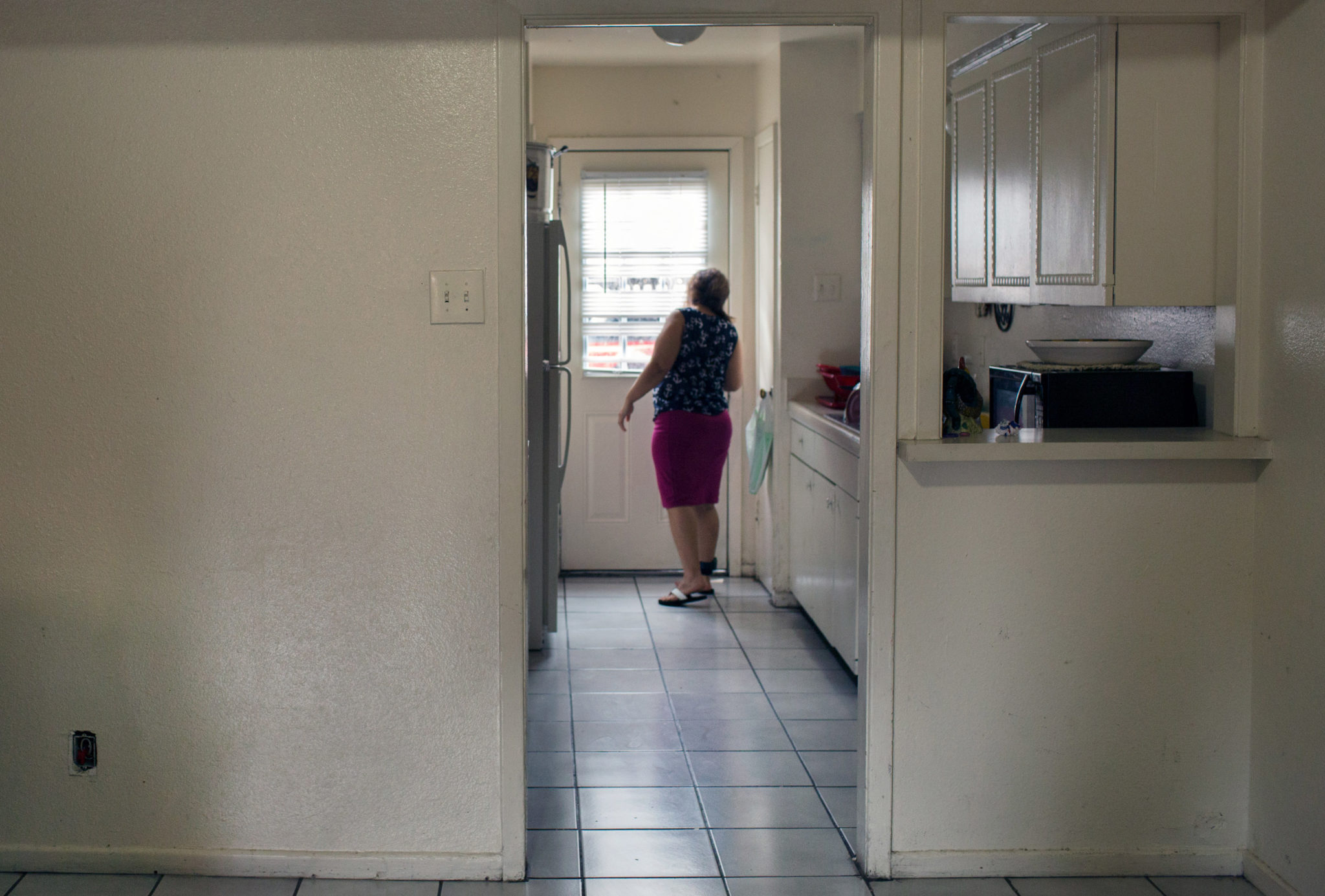
In Gladys’ apartment, noon comes and goes, and the BI employees haven’t shown up for the scheduled check-in.
After nine months, Gladys remains in the legal process — but barely. She still hasn’t turned in her asylum application, which she has to do within a year of arrival or be disqualified. The application is complicated and requires a lawyer’s help.
Once a month, she meets with a BI case specialist who supposedly helps with her legal case, but she says the employee simply gave her a list of lawyers, a list she’d already received at the border. She’s received no other assistance, she says. (An ICE spokesperson sent the Observer a list of case management referrals the company supposedly provides, ranging from help with legal petitions and filings to English classes and counseling.)
Fischer, the RAICES policy director, said, “There’s no quality work being done to make sure these families are proceeding with their legal cases.”
Gladys is left in a vicious cycle. She can’t get a work permit until after she turns in the asylum application. That limits her to working under the table, and the ankle monitor impedes her getting such jobs. (Yesica’s husband, a construction worker, has to provide nearly all of the seven-person household’s income.) With no hope of paying for a lawyer, her only chance is pro bono assistance.
About a week before my visit, Gladys made contact with a legal nonprofit in the area. Unrepresented, her chances of success would be virtually zero. But if the group can take her case, she’d have a fighting chance to avoid a plane ride back to Honduras — where the 18th Street gang awaits her.
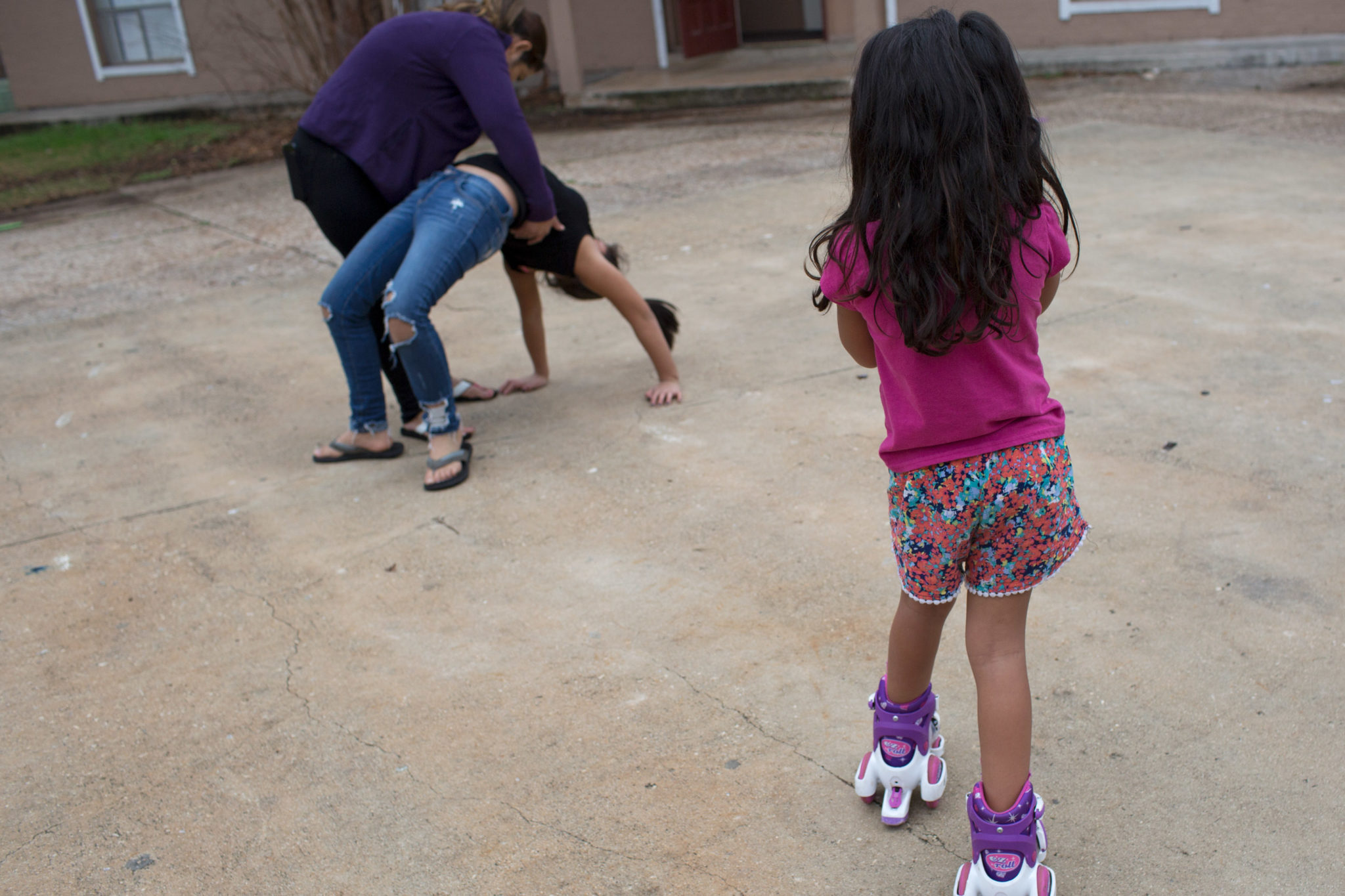
As we’re wrapping up, Gladys’ oldest daughter and Yesica’s son come home from school during their lunch break. They wave to us and disappear into one of the rooms.
I’m about to say goodbye when Gladys and Yesica ask if I want to go out for Mexican food. I agree, and Gladys goes into the bedroom to exchange her blouse and skirt for a T-shirt and baggy jeans. Before we leave, she turns her ankle outward for me to judge.
“It always shows, doesn’t it?” she asks.


